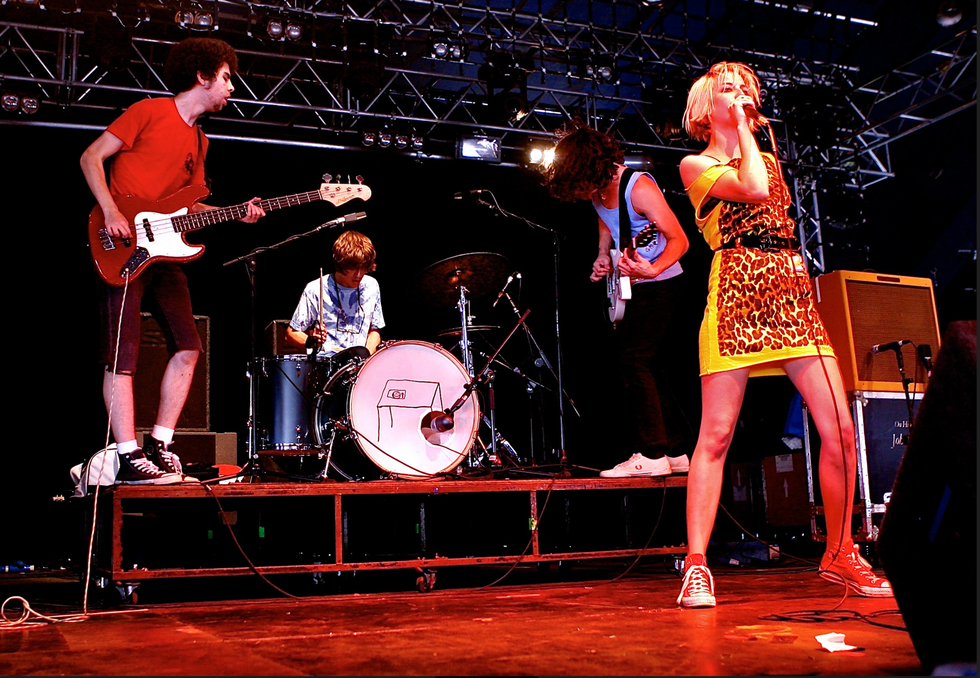In late August 2008, the members of Be Your Own Pet were in London, having just wrapped up the last leg of their final tour. Only two years prior, vocalist Jemina Pearl, guitarist Jonas Stein, bassist Nathan Vasquez, and drummer John Eatherly had been swept into the mainstream punk scene as teenagers, having received critical acclaim for their debut, self-titled album, going from small local stages to sell-out crowds around the world in what felt like minutes. “We were still very green at playing and making music together,” reflects Stein. “For whatever reason, it worked.” Then, they were waiting for their flights at Heathrow Airport, parting ways for what would become 13 years.
When it did eventually happen, the Nashville-based band’s reunion was swift. In late 2021, they met up at an event at Third Man Records (which is owned in part by Pearl’s husband, Ben Swank), after having loosely kept in touch over the decade or so prior. They had one rehearsal, Jack White caught wind of it—and they agreed to join him on a couple weeks’ worth of dates on his Supply Chain Issues Tour in spring 2022. And just like that, they were back.
Be Your Own Pet’s third full-length album, Mommy, was released on Third Man in late 2023. It’s their first record in 15 years, following 2008’s Get Awkward. The songs are boisterous yet tempered, at times charged, at times playful, and always joyous in their freedom of expression.
Erotomania
“It can be kind of easy to see through something that doesn’t feel totally authentic,” comments Stein on what makes a great punk band. By those terms, at the very least, Be Your Own Pet is great. On the new record, Pearl’s authenticity shines in lyrics that address her experience living with bipolar disorder (“Bad Mood Rising”) and sexual assault (“Hand Grenade”). Underpinning those sensitive, personal subjects, Stein’s insistent guitar work pushes them further to the forefront with the urgency they deserve.
The explosive, broiling Mommy poises itself like a zealous boxer, delivering one punch after the next in controlled bursts of enthusiasm. While the band picks up where it left off in their way of expertly packaging tumultuous—once teenaged—emotions into zipping, neatly clamoring arrangements, they’ve also become more articulate in their own musical language, going from pouring out raucous, nervous energy to fusing together beats, screams, and strums that are more confident than they are angsty.

On Mommy, Be Your Own Pet displays a new sense of confidence, channeling an angst that slightly departs from the energy of their teenage years to focus on more mature issues.
But don’t worry—they are still angsty. On the opening track, “Worship the Whip,” Stein switches between steady, supporting downstrokes to matching the vocal melody with a knifelike lead, as Pearl cries out with insolent commentary on right-wing authority figures. 'Goodtime!” is a lament on becoming an adult with responsibilities, especially as a punk—which Stein fleshes out with sharp, clever riffage. And on “Bad Moon Rising,” Stein savvily rides his overdrive back and forth between mild and heavy, paralleling Pearl’s shifting, riotous intensity. All the while, Vasquez and Eatherly act as bellows to the blaze, serving the songs with relentlessly energetic and intuitive rhythmic backing.
“In a very funny, positive way, there was always a little bit of hazing on one another, and all that stuff came right back.”
The first time Be Your Own Pet played together, Stein was around 15 years old. “I definitely did not have my driver’s license yet,” he says. “We had to get picked up by our parents to do rehearsals and stuff. Then shortly after, I was the first person to get my license, so we’d all pile into my car and go be rascals around town and play music when we could.”
It wasn’t long before the band gained traction—they released a demo CD, and soon after played South by Southwest, eventually signing to Thurston Moore’s Ecstatic Peace label to release their self-titled debut in 2006. What followed was a somewhat chaotic musical career that, due to the pressures of the industry, ended just a handful of years later. When they reunited, it was their first time seeing each other in person since their disbandment.
“I was always more inspired by the guitar players who can make two or three notes sound really badass.”
“Thirteen years sounds like a long time, but it did not feel like it’d been 13 years after we got back in the room together,” says Stein. “It just felt like meeting back up with your childhood best friends or your siblings, like ‘Oh, we know each other. We don’t have to try to figure each other out again.’ Aside from the musical chemistry, even the humor and personality traits that we all once carried…. They still carried over. In a very funny, positive way, there was always a little bit of hazing on one another, and all that stuff came right back.”

When Be Your Own Pet rehearsed together in late 2021, it was the first time they’d all seen each other in person in 13 years.
Photo by Angelina Castillio
Despite how quickly they fell back in step, a lot had also changed, but in a good way. The band had grown as musicians from the other projects they’d pursued over the years: Pearl released a solo album that featured Iggy Pop, Eatherly played with a handful of successful acts, and Stein fronted the band Turbo Fruits and built a career in DJing. “Coming back and doing it all again just felt like we were on performance enhancers,” says Stein.
During their time apart, Pearl also learned how to play guitar, which now enables her to bring more arrangement ideas to the rest of the band than her past, mostly lyrical contributions. “She’s been able to bring some really cool ideas that show up very barebones and rudimentary, which has been really nice because the boys are able to reconstruct and enhance them,” says Stein, referring to himself, Vasquez, and Eatherly. Compared to how they worked together when they were teenagers, today, they’re more comfortable with giving each other constructive criticism and feedback, and are able to come to agreements more easily. The “greater good” and what works for a song has taken priority over their egos and preferences as individuals.
But since the band was created when its members were in their formative years, there is still a subtle but “goofy pecking order,” says Stein. As the two oldest of the group, Stein and Pearl have always borne the “older-sibling responsibilities,” and more recently, Pearl has taken on the largest workload, he says. “She’s kind of wearing the crown in all this.”
Jonas Stein's Gear

While soloing, guitarist Jonas Stein, who’s inspired by bands like MC5 and Buzzcocks, either sticks to pure noise or uses as few notes as possible.
Photo by Jim Summaria
Effects
- Fulltone Full-Drive
- Electro-Harmonix Nano POG
- Generic wah
Strings & Picks
- D'Addario Nickel Wound (.011–.050)
- Dunlop Tortex .6 mm
Stein admits that when Be Your Own Pet started playing together again, he hadn’t played guitar for about six years, as he’d been spending most of that time focusing on DJing. So, when the band booked their dates with Jack White, he decided to invest in a new axe. He purchased a white Epiphone SG with the intention of hot-rodding it—and brought it to Dave Johnson of Scale Model Guitars in Nashville. He described to Johnson what he wanted the guitar to sound like, and Johnson went ahead with modding. “I just love something that breaks up pretty easily,” says Stein. “I don’t like my guitars to be too bright. I like them to be sort of easily distorted, really easy to play, and warm-sounding.”
Johnson gutted the electronics, adding Seymour Duncan humbuckers and simplifying the knob configuration (from four to two), changed the tuning pegs, replaced the nut, and put a custom Be Your Own Pet graphic over the body. Stein also plays a Gibson SG that Johnson modded years ago, which has an American flag graphic on it to resemble Wayne Kramer of MC5’s guitar. The pickups in the Gibson are stock. “I really like it; it’s kind of a darker, heavier tone,” Stein explains.
Live, Stein likes to play through a Fender Blues DeVille, but in the studio, he goes for “the weirdest, craziest, shittiest, fanciest-sounding amp there is.” For Mommy, he ended up recording a lot on a Peavey Decade. He explains how the amp rose to popularity after Josh Homme divulged that they were his “secret weapon” on the Queens of the Stone Age episode of the documentary series Watch the Sound with Mark Ronson. “These tiny little Peavey amps used to be like $40,” says Stein, “but now that the word is out there, they’re going for like over $1000 apiece.”
There are fiery leads and riffs on the album, but not solos in the traditional, elaborately improvised sense. As Stein explains, that’s never really been his speed. “I really took to the MC5 when I was a teenager. I liked the messiness and the imperfections of their playing. It made me feel better about myself as a guitar player because they were never perfect.
“I was always more inspired by the guitar players who can make two or three notes sound really badass and less focused on the players that were really well-versed in music theory and could play circles around everybody else. I was more into the energy that I would hear from a two-note Buzzcocks solo.”

This live performance shot was taken during the first phase of Be Your Own Pet’s career, when they were still teenagers.
Throughout the album, Stein captures that energy by bridling it in minimalist, yet galvanized, passages. Sometimes, that means a few measures of pure noise, à la Sonic Youth, heard on “Erotomania” and “Never Again.” Alternatively, on “Hand Grenade,” he builds a triumphant arc that perfectly suits the song’s impassioned, empowering message. And over the “Psycho Killer”-reminiscent groove of “Rubberist,” he carefully unravels a series of spacious phrases that climb over the steady bassline and eerie crowd vocals. His approach to that song in particular was influenced by his experience as a DJ, where he’s immersed himself in disco, Italo disco, funk, and dance genres.
Stein describes “Rubberist” as featuring “more time and space and less full-on riffage.” His disco familiarity comes into the songwriting process in terms of “knowing when to bring the guitar down, to let other things shine a little bit more, let the bass shine, let the vocals shine, let the drums and bass shine together. I think just being around more dynamic music, like some 8-minute deep-cut disco tracks, has shaped the way I would look at writing a song today.”
“I started from pretty close to beginner status. But I think that in itself is pretty punk rock.”
Citing Giorgio Moroder, Nile Rodgers, and Gino Soccio as influences, Stein shares, “I grew up mostly on punk rock and rock ’n’ roll and I was always like, ‘Disco sucks,’ ’cause that was always the theme. But listening to disco music and classic dance music from the early ’70s to early ’80s has been really refreshing for my ears. It’s so much different from what I was used to playing in all the bands I played in.
“I was on the tail-end of, you had to pick a clan and stick with them,” he shares. “In the ’80s, you were either a punk rocker, or a metalhead, or you went to discos. You couldn’t really cross over. But now, I feel like we’ve entered an age, probably because of the internet, where everything’s so immediately at your disposal that you can like anything you want and everything you want, and it’s okay.”
Stein was just becoming a musician when the world was in the midst of entering that age. He grew up with a dad who worked in the music industry, and while he was never “force fed” into learning an instrument, the opportunity was always there. When his parents did eventually put him in guitar lessons, he ended up hopping from guitar to drums to bass and back to guitar—which then, of course, led pretty quickly to him performing. “I probably, for certain actually, started playing in bands before I had the skills to play in bands.”
When it all began, he says, he strung his guitar with just the bottom four strings. He was mostly playing power chords at the time, and the other strings just got in the way—but as the band started getting more shows, his playing had to catch up to where he was as a performer. “I started from pretty close to beginner status,” he says, looking back. “But I think that in itself is pretty punk rock.”
Be Your Own Pet @ SXSW - 03/15/2023 - Mohawk, Austin, TX
In a performance at SXSW 2023, Be Your Own Pet rips through two tunes, digging in with unconventional arrangements and raw punk spirit.





















![Rig Rundown: AFI [2025]](https://www.premierguitar.com/media-library/youtube.jpg?id=62064741&width=1245&height=700&quality=70&coordinates=0%2C0%2C0%2C0)








 Zach loves his Sovtek Mig 60 head, which he plays through a cab he built himself at a pipe-organ shop in Denver. Every glue joint is lined with thin leather for maximum air tightness, and it’s stocked with Celestion G12M Greenback speakers.
Zach loves his Sovtek Mig 60 head, which he plays through a cab he built himself at a pipe-organ shop in Denver. Every glue joint is lined with thin leather for maximum air tightness, and it’s stocked with Celestion G12M Greenback speakers.












![Devon Eisenbarger [Katy Perry] Rig Rundown](https://www.premierguitar.com/media-library/youtube.jpg?id=61774583&width=1245&height=700&quality=70&coordinates=0%2C0%2C0%2C0)






